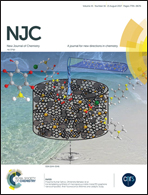Synthesis, photophysical properties and DFT analysis of highly substituted pyrido carbazole-based “push pull” chromophores†
Abstract
A series of new fluorescent pyrido[2,3-a]carbazole derivatives were synthesized in excellent yield through an efficient and single step strategy based on a four-component reaction with 2,3,4,9-tetrahydro-1H-carbazol-1-one, malononitrile, and aryl/heteroaryl aldehydes as synthetic inputs and sodium ethoxide (NaOEt) as a catalyst in methanol under reflux conditions. The structures of the compounds were established by FT-IR, 1H NMR, 13C NMR, X-ray diffraction and elemental analysis. The photophysical features of the synthesized compounds 5(a–q) containing “push–pull” scaffolds are investigated and reported with the aim of achieving good fluorescent materials. The UV-vis absorption and fluorescence emission of the compounds were studied in solvents of varying polarities and showed an increase in the solvent polarity, which led to an increase in the Stokes shift. This study revealed that the investigated compounds are highly fluorescent molecules (Φfl = 0.27–0.65) with lifetimes in the range of 7–9 ns. Furthermore, we analyzed for band gap energy associated with HOMO–LUMO, through DFT studies.



 Please wait while we load your content...
Please wait while we load your content...